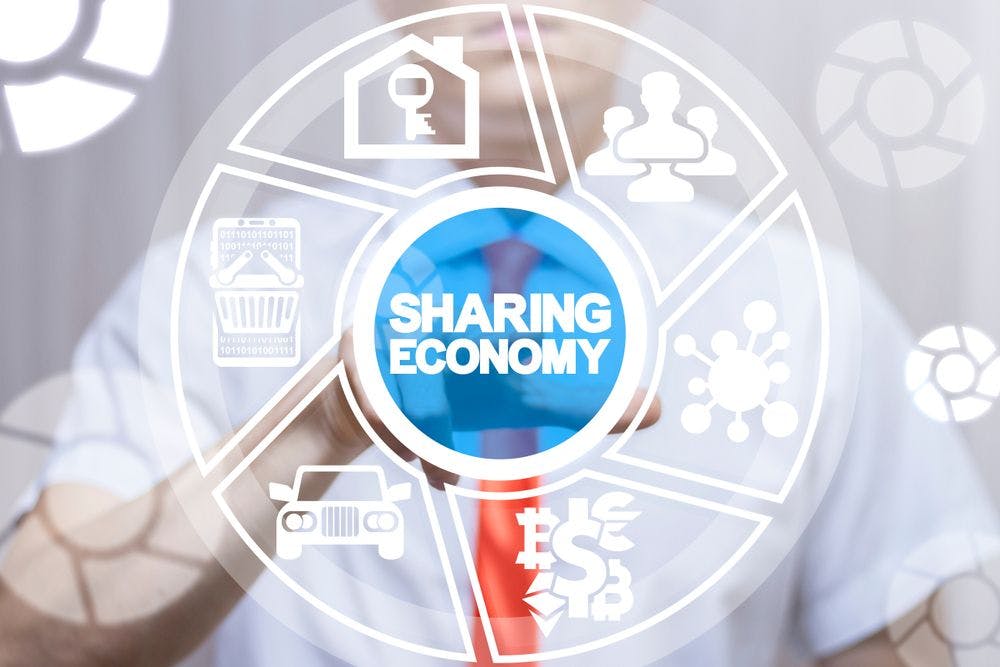
HOW TO BUILD A PEER-TO-PEER (P2P) MARKETPLACE FROM SCRATCH?
P2P platforms cover various niches and provide all kinds of goods and services — from online shopping, like eBay, to transportation services, such as BlaBlaCar. These marketplaces have been quickly exploring new niches, but the best thing is, that there is always space for innovation. So, keep reading to find out how to create a peer-to-peer marketplace.
WHAT IS PEER-TO-PEER MARKETPLACE?
Peer-to-Peer marketplaces are services that connect buyers and sellers without owning any resources. The platform is entirely powered on the community’s resources and activities — business owners have to provide the conditions for interactions and payments. P2P websites form P2P commerce — a unique kind of e-commerce model where users don’t rely on a single store but can connect to multiple sellers simultaneously and directly.
MAIN REASONS TO DEVELOP A PEER-TO-PEER MARKETPLACE
Peer-to-peer online marketplaces have been among the most successful business models of the decade. Etsy, Airbnb, and other international platforms where users can trade goods and services, quickly rose to prominence. Why are P2P marketplaces development thriving and how can business owners leverage these opportunities? Let’s take a look at the main reasons for peer-to-peer marketplace development.
Financial advantages
A peer-to-peer online marketplace doesn’t require business owners to invest in buying products or taking care of storage. The service relies on customers without risks from founders. The website development and promotion is the only significant investment, required from a business owner. Compared to traditional stores and marketplaces, this technology of business is practically risk-free. Business owners don’t have to focus on shipping or production, but instead can target strategic tasks and invest in growth.
Flexibility and innovation
Marketplaces are constantly evolving — they are among the first ones to adopt big innovations like Artificial Intelligence or big data. The reason behind that is quite simple: such marketplaces can focus on changes rather than on financial issues. The goals are clear — as soon as the marketplace attracts visitors, it will be successful. You are not tied to a particular country or industry — business owners always explore new fields and open new categories, if an interesting niche opened up.
Low entry barrier
A common myth about a digital startup is that an owner should necessarily know software development in detail. In reality, business owners prefer to hire dedicated teams who will be fully responsible for software development, testing, and maintenance. Even those owners who indeed had experience in programming, prefer not to spend time on tasks that can be easily outsourced.
This means the entry barrier for starting a peer-to-peer marketplace is very low. You need to have a concept, find a profitable niche, come up with a business model, and find a dedicated team for peer-to-peer website development. It’s enough to lay a foundation for a potentially multi-million company.
Immediate feedback
Peer-to-peer marketplaces provide a clear outlook on customer activity. You have regular statistics on purchases, users can rate the offers on the website, leave reviews, and communicate with each other. Business owners don’t even have to ask for feedback — users are usually eager to provide their opinions in reviews and ratings. This level of transparency isn’t that common in traditional B2C companies, because unlike in P2P platforms, users don’t feel being a part of the community.
Benefits of building an online P2P marketplace
Let’s take a look at the benefits of peer-to-peer marketplaces from the perspective of a customer, a seller, and a marketplace owner. This information will help you better understand how to create a peer-to-peer website and benefit from technology.
If you are a customer
Peer-to-peer shopping is a very comfortable option as consumers don’t have to run through many different online stores and can find everything they need on one platform.
The main benefits of the P2P marketplaces for the consumers are:
- A large variety of offers from different sellers at one place;
- Open access to the reviews and feedback from other users;
- An ability to compare different products and sellers and make an order on one platform.
If you are a seller
A peer-to-peer marketplace is a source of limitless opportunities for sellers. In short, the advantages boil down to:
- A large target audience gathered at one platform without the need to open an offline store;
- A chance to communicate with the customers directly and receive feedback in real-time;
- An opportunity to sell products to buyers all over the world and grow internationally.
If you are a marketplace owner
Owning a P2P marketplace platform offers a lot of different options for future development and enlargement, and that’s why it’s a great project to invest in.
Here are some advantages you could benefit from:
- Relatively low cost of starting a business;
- Great digital visibility which lets you reach large groups of people all around the world;
- A chance to earn users’ trust from both audiences: the sellers and the consumers;
- Ways to reach passive income and earn profit online without the need to produce the actual products;
- Growth in geometrical progression thanks to the word of mouth and personal recommendations of your platform by satisfied users;
- Relatively simple management system thanks to various ways of automation, results in tracking and analysis;
- No limits regarding the profits or the platform enlargement.

Features of a successful peer-to-peer online marketplace
Over the last two decades, we’ve seen the rise of many successful peer-to-peer marketplaces. eBay, Craigslist, Freelancer — all these platforms have quickly attracted an active community and are still highly relevant.
Because P2P marketplaces cross different niches and target audiences, it’s easy to miss a general pattern that unites all successful sites. In reality, the functionality of every successful P2P marketplace software can be broken down into simple building blocks, identical to every successful platform regardless of the date of foundation and niche. Here, we review this crucial functionality that makes these sites attractive to the audience and highly usable.
User profile
Sellers and buyers alike should be able to register a profile on the platform without specifying too much personal data. The platform should provide information on a person’s location contact information, and buying/selling preferences. Now, platforms include the possibility to register an account with social media credentials (Facebook, Google, etc).
Product listings
All users should be able to add a service or product to the website. As soon as the item is added to the marketplace, the website should provide the possibility to change the ad, edit the description, add pictures, or delete items. Customers should be able to comment, review, and evaluate the services or products. Transparent feedback is a crucial trust-forming factor.
Checkout
When customers want to purchase or rent a product, or order a service, they should be able to pay for it in a few clicks. The website must offer several payment options — direct bank transfer, credit card payments, and online wallets.
It’s important to note that checkout statistics are rather pessimistic: over 60% of website visitors leave the website before they complete the purchase. Main reasons are complicated checkout forms, the lack of transparency, and a slow shopping cart.
Notifications
The goal of a business owner is to make sure that customers can easily communicate with each other and quickly close their deals. Messages and replies shouldn’t get lost — most users won’t visit the platform to check their messaging history. The best option is to send alerts on the email addresses or phone numbers to make sure a person sees the message. You can also enable push-notifications, but avoid using them for spamming purposes.
Account verification
The platform’s revenue is only as real as its users. If the website is filled with bots and fakes, it won’t promote trust and the community will likely fail. Hence, there are two takeaways here. Never use bot farms and spam methods for promotions. All sign-ups should be legit. Also, you need to prevent spammers from registering on your website by querying an account verification. The easiest option is email verification — but it’s not the most efficient one since email accounts can be faked just as well. Examples of data that can’t be easily faked are mobile number confirmation or facial recognition.
WHAT YOU NEED BEFORE CREATION A PEER-TO-PEER MARKETPLACE?
The most important stage of developing a p2p marketplace is software development. The website's functionality and interface will largely determine the business’s success. Here, we broke down the process of building a marketplace into a step-by-step guide.
Summarize a business model

Before you start looking for a software development team and outlining the development process, you need to have a clear understanding of your business.
- Define a target niche.
Some marketplaces strive in several niches (eBay or Craigslist) while others focus on particular fields (Airbnb, Etsy). Decide which industry your solution will be targeted and define its target audience.
- Outline the functionality.
We already went through essential features — be sure to include them in your list. Also, you can include other possibilities, if your niche or audience requires that.
- Establish a business model.
P2P marketplaces have several ways of making profits: publishing advertising, taking a commission from purchases, providing premium subscriptions, offering additional paid functionality that promotes selected offers in the feed, etc. You can choose one of these ways, or combine several of them.
- Consider scaling opportunities. As the platform grows, you could potentially explore new niches or international markets. It’s best to be aware of these options early on — so you can act according to this vision even at the early stages.
These preparations allow business owners know exactly how to build a p2p marketplace and form a long-term vision before they start focusing on tasks at hand. Once the development starts, it’s easy to overlook strategic goals, so strive to outline them early on.
Choosing between a ready solution and custom development
To build your platform, you can use an open-source peer-to-peer marketplace such as Sharetribe or Magento or build your own.
The choice fully depends on:
- Your overall idea and features you want to implement;
- The budget you are ready to devote to this project;
- The time you have on your hands.
Open source platforms can be described as online templates that you customize and add a limited number of additional features. There are solutions on the market made specifically for creating peer-to-peer marketplaces such as Sharetribe, Marketplacer or Near Me. They let you customize the design and apply some features necessary for a P2P platform: payment systems, analytics, ratings, reviews, product listings, and so on.
Using a ready platform

If you need a simple and fast solution, and your idea isn’t overwhelmed with additional features, use open source peer-to-peer marketplaces.
Let’s see what pros and cons they provide, and how the building a peer-to-peer website process looks like on such platforms.
Advantages:
- Simplicity: all you need to do is register and figure out how to customize the template to fit your needs;
- Lower costs: developers will only have to focus on customization;
- Testing a business concept: ready services provide a fast way to validate a business model.
Disadvantages:
- Limitations: you won’t be able to add your designs or features, as you have to choose from the ones the platform offers;
- Potential scaling issues: the platform won’t let you bring innovative features to the market;
- No control over third-party technical issues: if a provider is down, your store will be inaccessible as well;
Developing a new platform

When a development team builds a platform from scratch, the owner has a say in every aspect of the marketplace: functionality, user interface, add-ons, analytics, admin panels. For developers, building a new platform is often easier than customizing the existing solution, because they can use comfortable tech stacks and structure code optimally.
Advantages:
- No limitations over the platform’s functionality, interface, administration, statistics, etc;
- Developers can provide expert consults for your business, translating business needs to software solutions;
- Scaling opportunities: you can add new features, improve the website's ability to withstand heavy traffic loads and optimize user experience;
- Simple maintenance: it’s easier for developers to identify mistakes with the features when they are working with their own code.
Disadvantages:
- A software development team is an obligatory investment — a business owner has to hire developers, UX/UI designers, and software testers.
- Increased expenses — such projects can last many weeks, depending on the complexity of the platform.
If a business owner already validated the marketplace’s concept, it’s better to develop custom code, since it’s easier to manage long-term. However, if the business model hasn’t been brought to customers yet, you can start on ready solutions, invest in the promotion to attract first visitors and verify that the target audience is interested.
HOW TO BUILD A PEER-TO-PEER MARKETPLACE WEBSITE?
Regardless of whether you choose a ready solution or invest in custom development, several aspects must be taken into account during development and customization.
1. Building a UX/UI interface
The development process starts with UX design. The team has to analyze the market and target audience, define personas and their needs, and come up with the style and structure that would appeal to target users. At this stage, a designer discusses the concept with the business owner and creates wireframes — rough prototypes of the website in software like Photoshop or Sketch. The ready prototypes are often uploaded to Figma — a collaborative design platform where teams can access and edit designs simultaneously.
2. Writing code for essential functionality
Developers start building basic features — the product feed, personal profile, admin panel, etc. They can either write features from scratch or integrate ready solutions or plug-ins. The best strategy is typically to combine integrations and custom development.
3. Setting up payment options
Developers have to enable card and bank transfers as well as PayPal and Stripe. Testers can cooperate with engineers at the very first stages. At this stage, it’s important to assure that the process is seamless and safe.
4. Building a mobile version
The platform should be responsive to Android and iOS devices alike. Developers and testers work on cross-platform optimization. Designers need to make sure that the interface corresponds with the dimensions of different mobile devices — the same aspect is valid for laptop screens as well.
After the solution was built and brought to different platforms, it’s time to release the platform to the market. From that point on, a business owner has to analyze the feedback and maintain the website.
Examples of P2P marketplace platforms
Business owners have to face the competition with well-established platforms and keep up with increasing user requirements. Let’s take a look at successful P2P marketplaces and their features in different industries. These platforms will also help you to answer the question of how to create a p2p marketplace and make it stand out.
Airbnb

Airbnb is an example of a successful P2P marketplace. The platform allows users to place their property for renting or book a room from locals. Initially, the marketplace only took care of renting a property, but now it also offers entertainment and adventures — an example of successful scaling.
Features
- Interactive map with search results: a user can see offers that are displayed in a particular location;
- Search filters: users can sort offers by their location, prices, rating, type of property, and owner’s language;
- Guest protection: the payment is withdrawn after 24 hours from the check-in date;
- Free listings: hosts place their properties for rent with no beforehand payments.
Airbnb made a priority of attracting as many hosts to the platform as possible. Guests are the ones to pay the fee — 6% to 12% from each offer.
Read more about how to build a website like Airbnb.
BlaBlaCar

An online marketplace for sharing rides allows people to find affordable rides. The platform has more than 100 million members and is launched in 22 countries, mostly in Europe. At first, the app didn’t charge commissions for deals but change price politics in favor of taking 20% commission.
Features
- Simple registration: users who are looking for cars have to specify the preferred destination, whereas drivers have to provide information about their vehicles;
- Direct contact: when the ride is arranged, two parties exchange mobile numbers;
- Private messaging: BlaBlaCar has a built-in messenger;
- Rating system: each user is invited to rate a driver once the trip is over.
Without owning vehicles, BlaBlaCar attracted more than 80 million users, relying completely on the community’s resources. It’s a great example of tapping into a profitable niche and efficiently executing the idea.
5miles

This is a proximity-based startup that allows users to connect to local buyers and sellers. The app relies on local communities and helps small businesses to find their audiences.
Features
- Location-based search: the customers can specify the search range;
- Search filters: the results are sorted by the niche, rating, and price;
- Private messaging: buyers can directly contact sellers.
5miles is an example of a small startup that managed to build loyal local communities and be successful in that narrow niche.
Our Experience
We enjoy working with marketplaces because of all the global scaling opportunities. At Gearheart.io, we build web peer-to-peer marketplaces in one or several niches alike, ready to take on projects with any scope. Our experts provide professional consults on scaling opportunities, while the technical team of developers and designers builds an intuitive platform for the community.
If you have any questions on how to build a peer-to-peer marketplace or have ready ideas for a P2P marketplace, drop us a line. If there is no business model yet, we are ready to help with refining and verifying it. Our team will answer your questions, evaluate the development costs, and offer a perfect way to build your peer-to-peer marketplace from scratch.
Subscribe for the news and updates
FAQ
What is peer-to-peer marketplace?
How do I create a peer-to-peer website?
How to develop a peer-to-peer marketplace?


